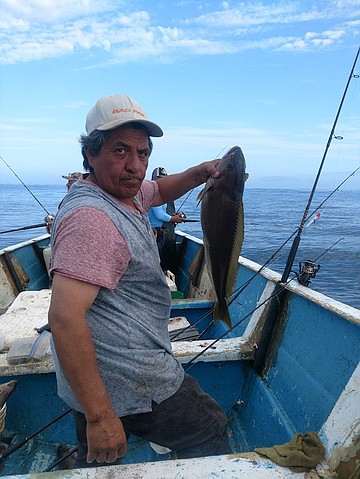Rough conditions, the return of a yellowtail tournament
Blue-collar commercial fishing in Mexico
Dock Totals 7/30 – 8/5: 4711 anglers aboard 189 half-day to 3-day trips out of San Diego landings over the past week caught 1 albacore, 88 barracuda, 12 blacksmith perch, 2687 bluefin tuna (up to 263 pounds), 146 bonito, 1 cabezon, 3614 calico bass, 4 croaker, 386 dorado, 9 halibut, 6 lingcod, 1076 rockfish, 314 sand bass, 1 sargo, 49 sculpin, 218 sheephead, 1 thresher shark, 1 treefish, 78 whitefish, 6 white seabass, 124 yellowfin tuna, and 747 yellowtail.
Saltwater: Seems the pelagic catch is shifting from blue to yellow and gold, with fewer bluefin and more yellowtail and dorado in the counts this past week. That said, going back through the counts over recent years, one can see a lot of fluctuations in species and numbers caught. The fishery can change on a dime with a shift in wind, storms, or tidal movements. A plethora of bait can leave fish fat, sated, and unwilling to bite, or the opposite, a wide-open line wrapping gamefish frenzy can erupt through a mass of sardine or anchovy.
This past week’s reduced number of trips and anglers is at least partially due to rough conditions around a full moon/king tide phase. Given that, the counts are very good, especially the increase in calico bass, which is a result of more boats sheltering nearer the coast or the lee sides of islands in rough seas. Water conditions also explains the drop in rockfish counts as those species are generally caught from high spots on the open sea. Even so, those who made it out did well on bluefin and yellowtail before and after the whitecaps and large swells.
On Saturday, August 5, I fished in Don Eddie’s Annual Yellowtail Tournament, hopefully the first of many to come. Don Eddie’s is under new ownership, and the new Eddie is reviving the once popular yearly tournament that ended years ago. While the property sitting on the north side of El Molino Viejo is being revamped with added bayside cottages and more, the new owner is also rebuilding the fishing vibe and is looking to add more fishing tournaments and activities for all to enjoy. There weren’t many entrants, and believing the odds were good for a thousand-dollar yellowtail, we competitors dusted off the previous night’s revelry and headed out into the gray light with high hopes.
The week previous held really good yellowtail fishing, and even a few dorado were caught in the (for San Quintin) balmy 67-70-degree water. Then we had three days of wind after the King Tide and full moon, which left the water too choked with spindrift kelp, eelgrass, and sargasso for trolling. The wind and tidal upwelling knocked the water temp down to a very-chilly-for-yellowtail 60 degrees. Our hopes began to fade as, though there were huge balls of bait everywhere, nothing but birds were picking at it. No boils or foamers of yellowtail and huge bonito as there was the week before when I was out with commercial fishing friends targeting whitefish.
Through the day, a few yellowtail were caught by anglers near San Martin Island and off the 240-bank, but none by any of the tournament entrants. As usual for the fishery, some very large whitefish, vermillion rockfish, a few fat sheephead to 14-pounds, and a couple decent lingcod were caught for the day. The tournament will be on again next year in August, though the date will be a little more removed from the full moon and king tide to offer a better chance at targeted species, which will also increase to include halibut, white seabass, lingcod, and possibly whitefish and sheephead.

My outing with my commercial friends the week before was an invite I couldn’t turn down. I wanted to see just how much work it was to rod-and-reel whitefish on 3 and 4-hook rigs at a pace beyond the recreational limits. I was ‘hired’ for my fishing experience and gear, and was expected to do my part in filling the ice chests. It looked simple enough as we headed out in the morning; there were a few large ice chests aboard, each able to hold about 70-kilos of stacked whitefish, for which the fish market pays 30-pesos per kilo. The rule is fish until you fill them; the first chest covers the two-thousand peso fuel expense, the rest are what the crew splits. The working conditions were okay for a young fellow, but my cranky old spine had had enough of no seats and working on a rocking platform by 6pm when we were still 20-miles offshore topping out the second ice chest.
We did, however, enjoy the traditional and delicious fresh ceviche made at sea mid-day. With the second chest packed full, we called it a day and headed in, reaching the boat ramp after sundown. It was a great experience, though I do believe I had a double charley-horse on my rump from the narrow divider that offered the only seating while under way on bumpy seas. And I earned an average daily wage for a worker, even if not up to snuff for commercial fishing Mexican style. My hard-earned 500-pesos in hand, I stumbled into my room at 8pm and slept for 12 hours…Asi es, that’s why they call it fishing and not catching…They’re out there, so go get ‘em!